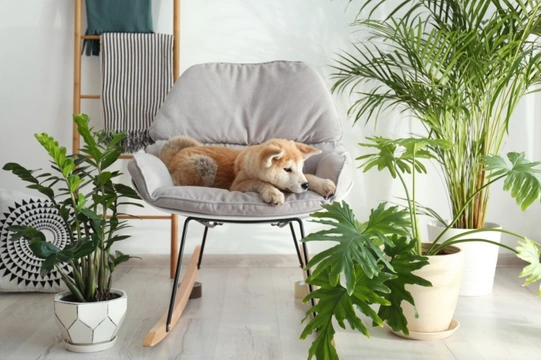
Why Does My Dog Steal My Seat?
Most dog owners are familiar with getting up to get a cup or tea or use the toilet and coming back to find their dog curled up happily in the seat they’d planned to come back to. Some dogs seem to be able to achieve this in a split second too, even if they appeared to be fast asleep when you first moved!
So, why does my dog steal my seat? There are a number of reasons for this, which we’ll explain below. Read on to learn more.
It’s probably “your” seat for a reason
First up, look for the simplest potential solutions first! Why is your seat yours? Probably because there’s something about it that makes it the best seat.
This could be that it’s the warmest, most comfortable, gives the best view of the room, or perhaps the best view of the TV; while this latter is probably not a big incentive for your dog, the other factors might mean you have competition for it.
You’ve left it warm
If you’ve been sitting in your seat for a while, it will be warm by the time you get up, and this could well be a big part of the appeal for your dog. If the whole room is uniformly warm and there is no shortage of warm seats, you can probably rule this factor out.
This is definitely worth bearing in mind otherwise as some dogs never seem to be happy unless they’re very hot!
They know it will get a reaction from you
So you want your seat back, or are just bemused at the speed at which your dog managed to spot that it was free and leap into it, swiftly looking to all intents and purposes like they’d been in it the whole time… You’re going to react, one way or the other.
Whether you try to evict your dog, laugh at them, or give them a pat, if your dog knows they’re going to get a reaction out of you (and for many dogs, a tussle over the space is a huge reward) then this really ups the stakes for them and the value to them in leaping into your seat as soon as they have the chance.
They want to be close to you
Your seat might well appeal to your dog just because it’s yours, and you use it regularly. This means that it’s not the seat or spot that your dog is a big fan of, but the fact that it belongs to you. This is likely to be less about stealing your resources (although this is something we will look at towards the end) but more about them wanting to be close to you.
If they cannot be close to you personally then the space you just left is the next best thing. Also, if your dog is small (and in some cases even if they’re not!) your dog might hold out hope that when you return to your seat and try to reclaim it, you’ll let them snuggle up on or next to you.
It smells of you
Dogs know just what their owners smell like, even if to people you don’t smell of anything at all. Think of your favourite smell in the world, the one that makes you look like one of the Bisto kids when you catch a trace of it; for your dog, that smell is you.
Your clothes and other fabrics all become infused with your scent (once more, usually indetectable to people unless you’re in need of a bath!) which means the seat you sit in regularly will smell like you, which might make your seat your dog’s favourite place.
Your dog has trained you
Providing feedback and a reaction when your dog gets into your seat is something we mentioned earlier on, but there’s another potential facet to this as well. For instance, if you bribe your dog off your seat, you’ve probably established the seat-stealing behaviour very firmly, and made it very transactional for your dog!
One of the fastest and easiest ways to make a dog move (or to make a dog so anything, really) is to offer a food inventive.
So if when your dog first stole your seat, you gave them a treat to move, and have done so since, it’s fair to say you haven’t trained your dog to move from your seat, but rather, your dog has trained you to give them treats.
It could be a dominance issue
Finally, seat-stealing can potentially be a dominance issue in some dogs. By taking your resource, they’re letting you know, potentially subtly and with no aggression or pushiness, that they are the authority or pack leader.
If you let them stay in the seat then, you’re essentially agreeing with them. This doesn’t mean you have to move your dog from your seat every time they do this on principle if you don’t want to; but it does mean that if and when you do choose to move your dog, they get up when told on command, and vitally, never growl or try to turn things into a standoff.
If your dog is pushy or dominant about this, you need to correct the behaviour firmly and consistently.



